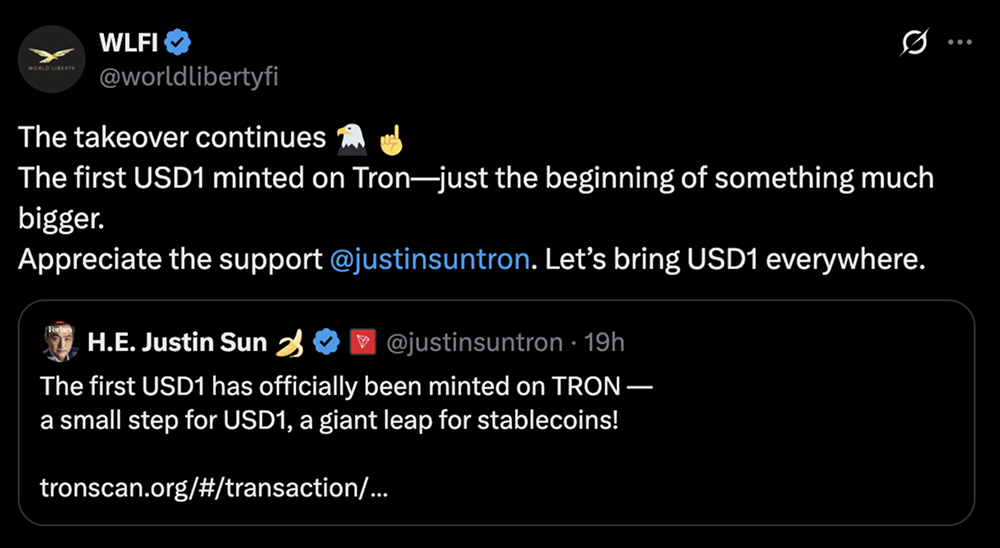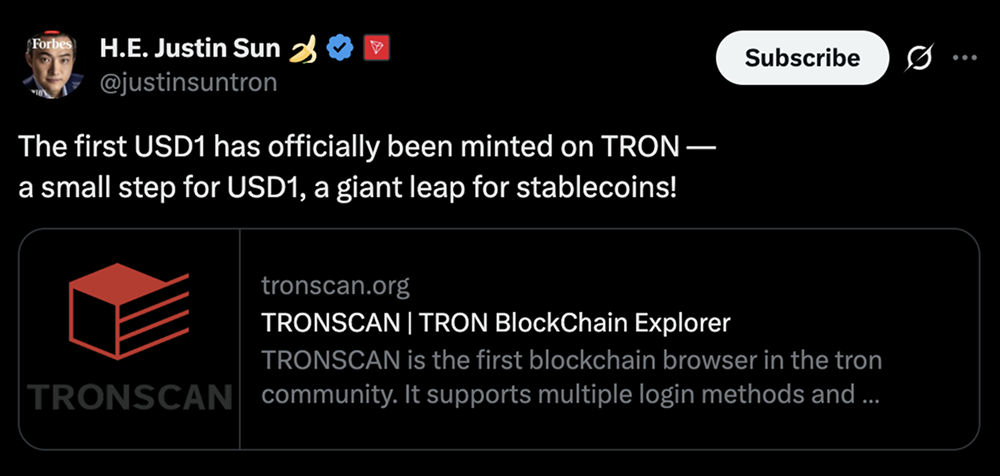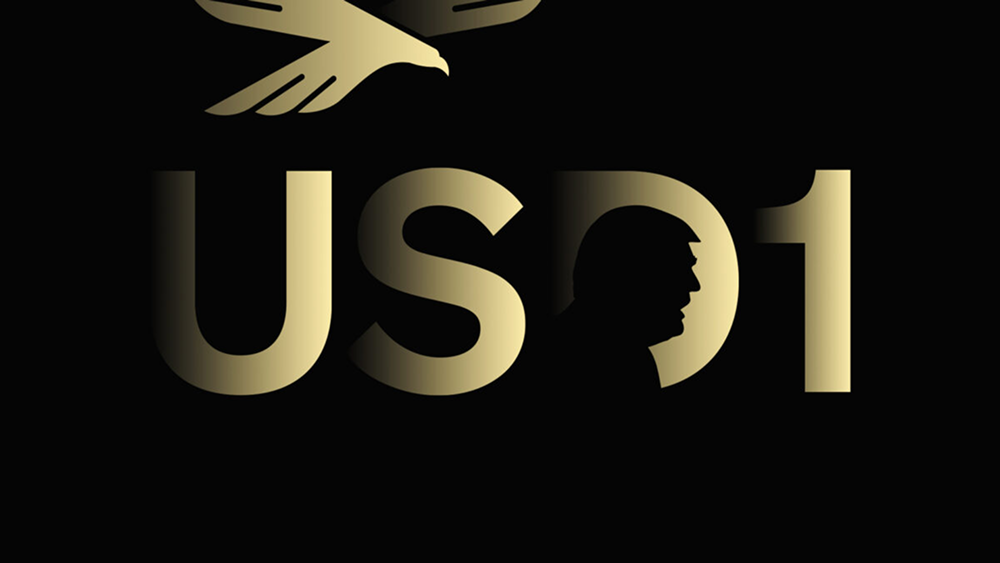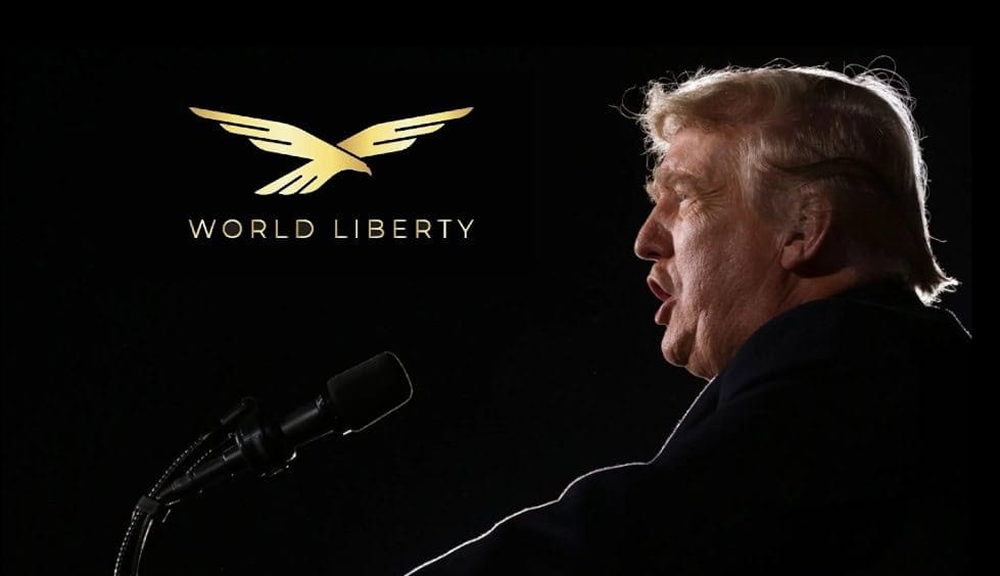On June 11, the DeFi platform World Liberty Financial (WLFI), closely associated with the Trump family, announced that its stablecoin USD1 has officially been minted on the TRON network.

The emergence of USD1 is not just the entry of a new player in the stablecoin arena, but also an experiment in observing how political influence translates into financial products, and how it will respond to market competition and regulatory scrutiny.
Technical and Market Choices: The Strategic Value of the TRON Network
According to TRON founder Justin Sun's confirmation on his X platform, the first batch of USD1 has been successfully issued on the TRON blockchain. WLFI's choice of TRON as a key part of its multi-chain deployment is clear in its strategic intent. TRON is known for its extremely low transaction fees and high throughput, providing the technical foundation for USD1 to realize its narrative of "inclusive finance." For a stablecoin aimed at attracting a broad retail user base, a low-cost, high-efficiency trading experience is crucial for its mass adoption.

WLFI positions USD1 as a compliant alternative to Tether (USDT) and USD Coin (USDC), claiming it is backed by 100% cash and cash equivalents (such as short-term U.S. Treasury bonds) and strictly adheres to AML/KYC regulations. As the largest USDT circulation network globally, TRON has a vast user base for stablecoins.
The launch of USD1 on TRON is akin to directly entering a mature market, attempting to siphon users and funds from it, which is far more efficient than building an ecosystem from scratch.
Market Performance: Highlight Data and Liquidity Concerns
Since its launch in March 2025, USD1 has shown impressive initial market enthusiasm.
According to Kaiko data, after landing on Binance in May, its transfer volume exceeded $10 billion within 10 days. However, behind the impressive data lies skepticism about its real demand and liquidity depth. On-chain analysis shows that USD1's trading volume is highly concentrated in a few wallet addresses, raising discussions about whether its market activity reflects genuine user behavior or is driven by internal liquidity guidance.

Additionally, WLFI conducted a "symbolic" airdrop at the beginning of June, distributing 47 USD1 tokens to certain holders, which was widely interpreted as a tribute to the 47th U.S. President, Donald Trump. This marketing tactic of integrating political symbols into financial products further highlights the uniqueness and controversy of USD1. Although the airdrop somewhat increased the token's on-chain decentralization, its restrictions in jurisdictions like New York exposed the real challenges it faces on the compliance path.
Political Background and Regulatory "Double-Edged Sword"
The most striking label for USD1 is undoubtedly its deep association with the Trump family. WLFI's founding narrative—stemming from the Trump family's experience of "de-banking" in New York—aims to serve groups marginalized by the traditional financial system, giving it a strong political color from the outset. Trump himself is positioned by the project as the "Chief Crypto Advocate," and the involvement of family members further brings this association to the forefront.

However, this political halo is a "double-edged sword." It can quickly attract supporters with similar political views, forming a solid community base. At the same time, it inevitably makes it a focal point for political opponents and regulatory agencies.
Despite WLFI repeatedly emphasizing its compliance and enhancing transparency through partnerships with institutional custodians like BitGo, its close ties to politics have placed it under the regulatory spotlight.
Outlook: Seeking Breakthrough Amid Controversy
USD1 is striving to expand its market footprint through its multi-chain deployment strategy (covering Ethereum, BNB Chain, and TRON) and active cooperation with exchanges. The Abu Dhabi investment firm MGX announced it will use USD1 for large investments, seen as a significant breakthrough in institutional adoption.
However, challenges remain. Compared to entrenched USDT and USDC, USD1 still has a long way to go in terms of institutional collaboration, ecosystem incentives, and market depth. Its market capitalization of approximately $2.18 billion still appears small in the vast stablecoin market.
In Conclusion
The launch of USD1 on the TRON network is a key step in its expansion strategy and a bold attempt to penetrate the financial realm with political influence. Whether it can transcend the realm of a "political meme" and truly become a competitive player in the stablecoin market will depend on its operational team's ability to navigate the complex regulatory environment and build a genuinely vibrant financial ecosystem.
In the future, the market will continue to observe whether USD1 will become a rising star or ultimately be defined and limited by its strong political color.
免责声明:本文章仅代表作者个人观点,不代表本平台的立场和观点。本文章仅供信息分享,不构成对任何人的任何投资建议。用户与作者之间的任何争议,与本平台无关。如网页中刊载的文章或图片涉及侵权,请提供相关的权利证明和身份证明发送邮件到support@aicoin.com,本平台相关工作人员将会进行核查。




